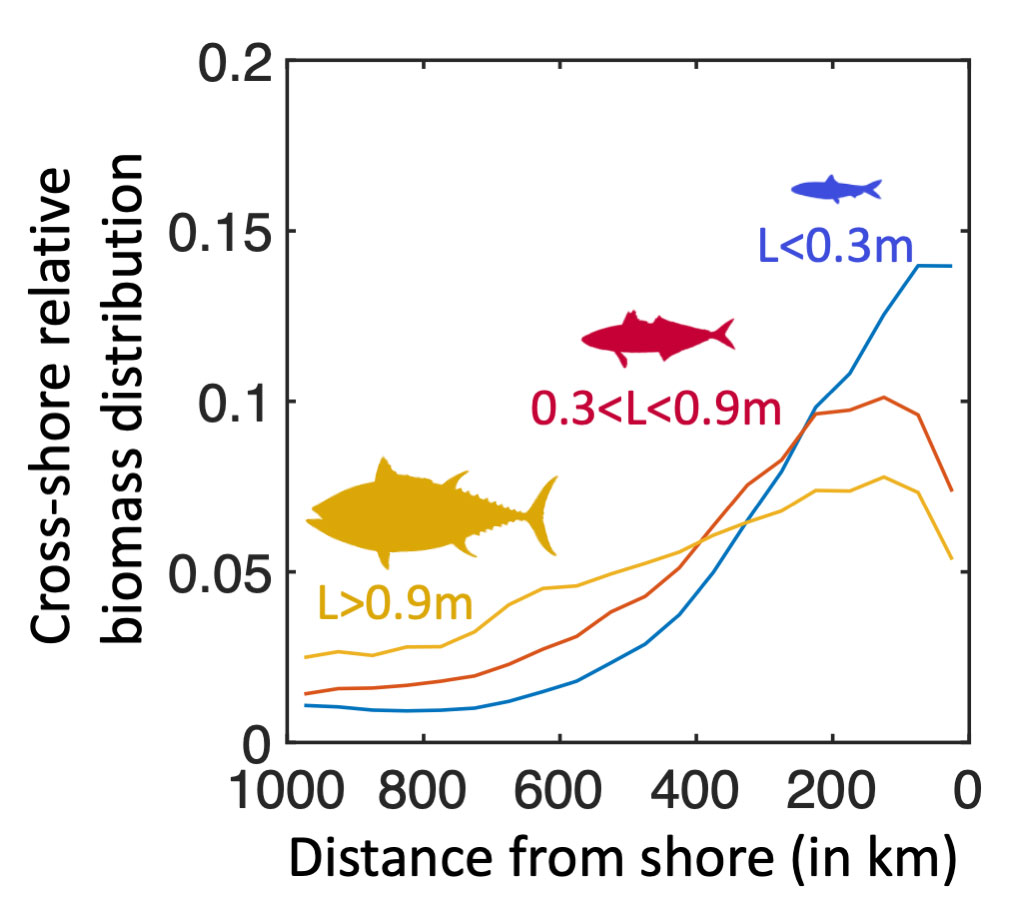News
Scientists Use SDSC’s Expanse to Better Understand California Current Ecosystem
Published July 21, 2022
Mahathi Gorantla (REHS Student) and Kimberly Mann Bruch
While terrestrial animals move on their own accord, fish are constantly being pushed by currents as they swim. An international group of researchers recently used Expanse at the San Diego Supercomputer Center at UC San Diego to examine these varying types of currents, specifically those found within the California Current Ecosystem (CCE)—a dynamic environment in the eastern North Pacific Ocean that spans nearly 3,000 kilometers from southern British Columbia, Canada to Baja California, Mexico.
The scientists’ simulations were recently published in a Frontiers in Marine Science journal article entitled Movement Shapes the Structure of Fish Communities Along a Cross-Shore Section in the California Current.
Their study illustrated how the currents within the CCE carry coastal animals miles away from their “home base” as a result of powerful eddies and filaments that transport water from near shore into the open ocean. Along with moving water and fish, the open ocean eddies and filaments can also trap these fish in swirling vortices.

This cross-shore fish biomass spread illustrates how the species of increasing size inhabit increasingly offshore habitats; this is due to their ability to track ephemeral eddies and fronts shaped by ocean physics. Credit: J. Guiet, UCLA
“Our results highlight the importance of currents and swimming fish in structuring the pelagic food web, and suggest that a representation of these processes can help to improve the realism in simulations with marine ecosystem models,” explained co-author Fayçal Kessouri, a senior scientist at the Southern California Coastal Water Research Project. “These circulation features generate environmental variations, or ‘fronts’ at scales of kilometers that influence the suitability of the environment to fish, shaping figurative hills and valleys where species will thrive or that they will avoid.”
Kessouri said that despite knowing that these variations are able to determine the areas that a fish will either thrive in or avoid, it is still unknown how these features affect the abundance of fish and the productivity of their ecosystems.
Kessouri and his colleagues were able to glean a bit of light onto the topic, however, as they developed complex numerical models that were able to realistically represent the physical circulation of the CCE and the physiology of coastal fish species of various sizes, ranging from a few centimeters to a few meters. Their analysis explains how fish species are able to thrive in a constantly changing environment.
“Our research reveals that coastal waters, fueled by upwelling of deep nutrients, support large populations of small fish species (e.g., sardines and anchovies) that feed on zooplankton and other tiny animals; however, surface currents constantly move these organisms away from the coast. From this region, species of increasing sizes (e.g., albacore tuna and swordfish) spread increasingly offshore by tracking ephemeral “oasis” where small fish remain trapped, generated by fine scale features such as eddies, in regions that would otherwise be unsuitable,” explained first author, Jerome Guiet, an associate researcher at the University of California Los Angeles (UCLA). “Thus, the presence of very dynamical currents and ocean ‘weather’ is essential to maintain the richness of predators that we observe offshore in Californian waters.”
This simulation shows the fish biomass density dynamics for individuals smaller than 30cm and larger than 90cm. Smaller organisms (L<30cm) remain closer from the shore while large organisms (L>90cm) track ephemeral eddies and fronts shaped by ocean physics. Credit: J. Guiet, UCLA
This understanding of how the environment can influence when and where a fish species emerges is instrumental to better managing these fish species and projecting the biomass of fish in a changing ocean environment that has become victim to overfishing. The researchers believe that this information allows better protection of endangered species, and they also believe that this is especially important in an ecosystem like the CCE where climate change is driving warming, ocean acidification and hypoxia to become increasingly threatening to fish communities.
Guiet, Kessouri and their teams also worked with researchers at the Institut de Recherche pour le Development in France on this project. They said that the next step in their research is to investigate how climate variability can influence the abundance of fish within the CCE. They also want to learn more about a possible link between fish biomass variations along the broader coastal region and inter-annual variations in coastal upwelling. The group hopes to use the recently published model to provide future projections of fish abundance in the CCE, as the ocean warms, exploring different scenarios of fishing and resource management.
The work on Expanse was funded by the National Science Foundation Extreme Science and Engineering Discovery Environment (grant no. TG-OCE170017).

